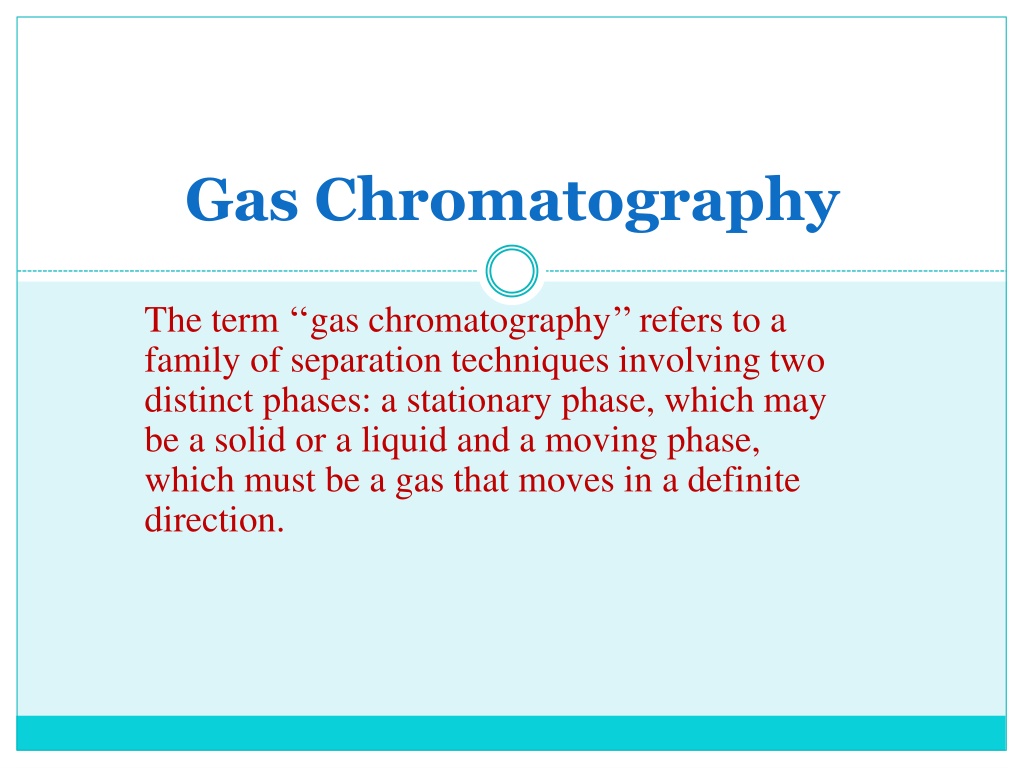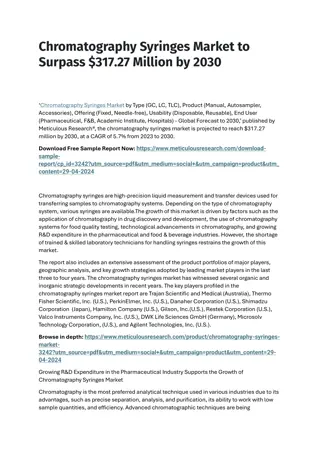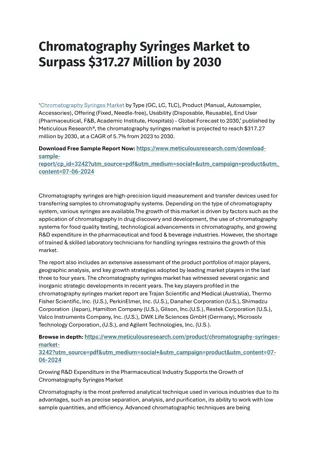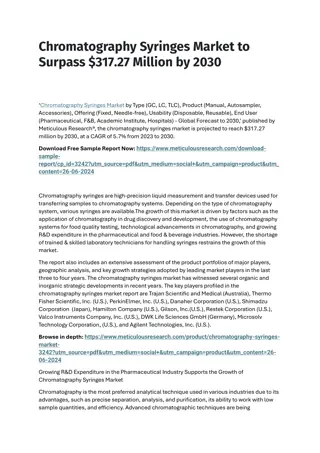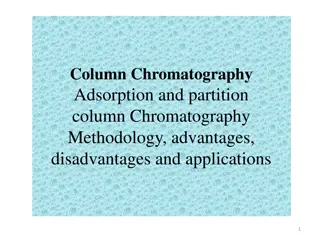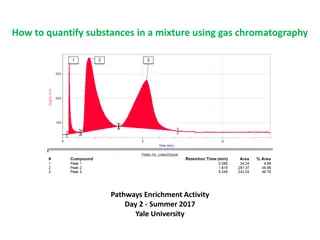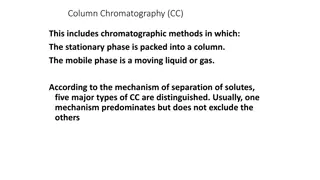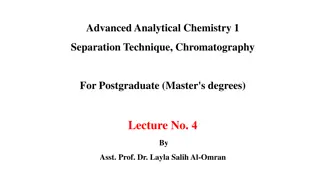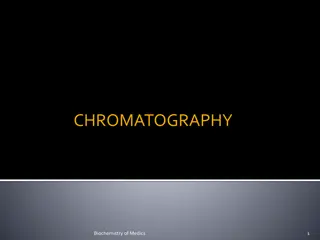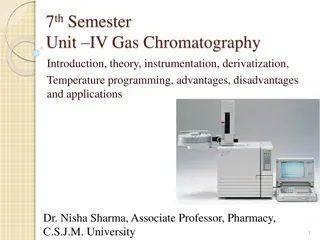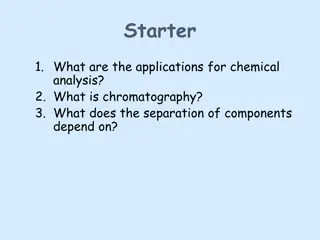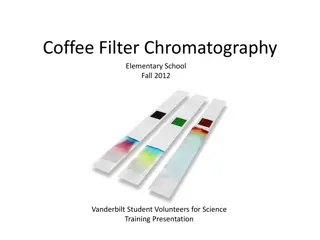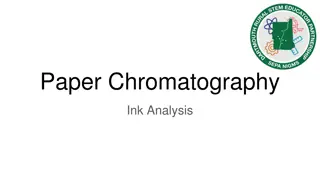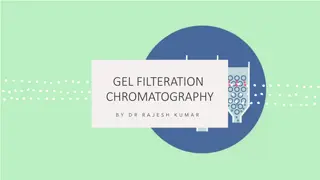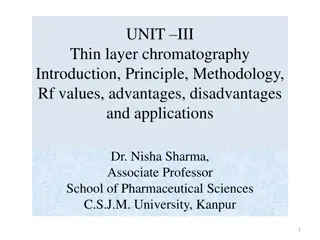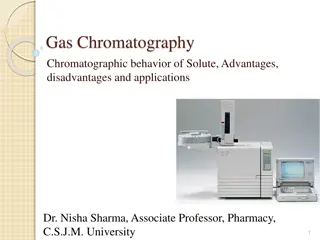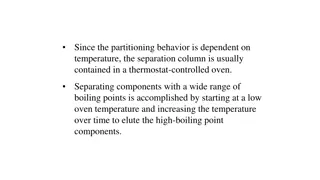Understanding Gas Chromatography: Principles, Applications, and Strengths
Gas chromatography is a separation technique involving a stationary phase and a gas mobile phase. The principles involve flowing a gaseous mobile phase through a column for separation based on component interactions. While its use in drug analysis has declined with the advent of HPLC, GC is still valuable for qualitative analysis and specific quantitative applications. Its strengths include high separating power with capillary columns, automation capabilities, cost-effectiveness, and suitability for compounds lacking chromophores.
Download Presentation

Please find below an Image/Link to download the presentation.
The content on the website is provided AS IS for your information and personal use only. It may not be sold, licensed, or shared on other websites without obtaining consent from the author. Download presentation by click this link. If you encounter any issues during the download, it is possible that the publisher has removed the file from their server.
E N D
Presentation Transcript
Gas Chromatography The term gas chromatography refers to a family of separation techniques involving two distinct phases: a stationary phase, which may be a solid or a liquid and a moving phase, which must be a gas that moves in a definite direction.
Principles A gaseous mobile phase flows under pressure through a heated tube either coated with a liquid stationary phase or packed with liquid stationary phase coated onto a solid support. The analyte is loaded onto the head of the column via a heated injection port where it evaporates. lt then condenses at the head of the column, which is at a lower temperature. The oven temperature is then either held constant or programmed to rise gradually. Once on the column separation of a mixture occurs according to the relative lengths of time spent by its components in the stationary phase. Monitoring of the column effluent can be carried out with a variety of detectors.
Introduction The use of gas chromatography (GC) as a quantitative technique in the analysis of drugs has declined in importance since the advent of HPLC and the increasing sophistication of this technique. However, it does still have a role in certain types of quantitative analysis and has broad application in qualitative analysis. Since HPLC currently dominates quantitative analyses in the pharmaceutical industry, the strengths of GC may be overlooked. Capillary GC is capable of performing much more efficient separations than HPLC although with the limitation that the compounds being analysed must be volatile or must be rendered volatile by formation of a suitable derivative' and must also be thermally stable, GC is widely used in environmental science, brewing, the food industry. perfumery and flavourings analysis, the petrochemical industry, microbiological analyses and clinical biochemistry. Although packed column GC is still used in the pharmaceutical industry, open tubular capillary GC, is the more modern manifestation of GC.
Applications ( ) The characterisation of some unformulated drugs, particularly with regard to detection of process impurities. Limit tests for solvent residues and other volatile impurities in drug substances Sometimes used for quantification of drugs in formulations, particularly if the drug lacks a chromuphore. Characterisation of some raw materials used in synthesis of drug molecules. Characterisation of volatile oils (which may be used as excipients in formulations), proprietary cough mixtures and tonics. and fatty acids in tixed oils. Measurement of drugs and their metabolites in biological fluids.
Strengths Capable of the same quantitative accuracy and precision as high-pressure liquid chromatography (HPLC), particularly when used in conjunction with an internal standard. Has much greater separating power than HPLC when used with capillary columns. Readily automated. Can be used to determine compounds which lack chromophores. The mobile phase does not vary and does not require disposal and, even if helium is used as a carrier gas, is cheap compared to the organic solvents used in HPLC.
Limitations Only thermally stable and volatile compounds can be analysed. The sample may require derivatisation to convert it to a volatile form, thus introducing an extra step in analysis and. potentially, interference. Quantitative sample introduction is more difficult because of the small volumes of sample injected. Aqueous solutions and salts cannot be injected into the instrument.
Instrumentation (i) Injection of the sample may be made manually or using an auto-sampler through a resealable rubber septum. (ii) The sample is evaporated in the heated injection port area and condenses on the head of the column. (iii) The column may either be a capillary or a packed column, which will be discussed in more dctail later, The mobile phase used to carry the sample through the column is a gas - usually nitrogen or helium, (iv) The column is enclosed in an oven which may be set at any temperature between ambient and ca 400 C, (v) The most commonly used detector is the flame ionisation detector (FID),
Instrumentation GC instrument
Instrumentation Syringes The volumes injected in GC are routinely in the range of 0.5-2 l. The most commonly used type of syringe is shown in the following Figure; the usual syringe volumes are 5 and l0 l. GC oven GC ovens incorporate a fan which ensures uniform heat distribution throughout the oven. They can be programmed to either produce a constant temperature, isothermal conditions or a gradual increase in temperature.
Types of column 1. Packed columns The columns are usually made from glass which is silanizcd to remove polar silanol Si-OH groups from its surface that can contribute to the peak tailing of the peaks of polar analytes. These columns have internal diameters of 2-5 mm. The columns are packed with particles of a solid support which are coated with the liquid stationary phase.
Packing materials The most commonly used support is diatomaceous earth (mainly calcium silicate). This material is usually acid washed to remove mineral impurities and then silanized to remove the polar Si-OH groups on the surface of the support, which can lead to tailing of the analyte peak. The support can then be mechanically coated with a variety of liquid stationary phases.
Types of column 2. Capillary columns Capillary columns are made from fused silica, usually coated on the outside with polyamide to give the column flexibility. Coating on the outside with aluminium has also been used for high temperature (> 400 C) work. The internal diameter of the columns ranges between 0. 15 and 0.5 mm. The wall of the column is coated with the liquid stationary phase, which may have a thickness between 0.l and 5 pm.
Types of capillary coating The most common type of coating is based on organo silicone polymers, which are chemically bonded to the silanol groups on the wall of the column and the chains of the polymers are further cross-linked, These types of phases have more or less replaced the wall- coated open tubular (WCOT) and support coated open tubular (SCOT) columns, which arc reported in earlier literature, for most routine applications. SCOT columns are sometimes encountered in very high temperature work. The wall-bonded phases are stable to at least 325 C and some types of coating will withstand temperatures of 370 C.
Carrier gas The most commonly used carrier gas in capillary GC is helium and the flow rates used are between 0.5 and 2 ml/min. Since the flow rate from the end of the capillary column is low compared to the internal space of some detectors, 'make up` gas often has to be added to the gas flow post column in order to sweep the sample through the internal volume of the detector at a reasonable rate. Typically cu 100 ng per component is loaded onto a capillary column. Selectivity of liquid stationary phases
Packed vs Capillary column GC Packed column GC Capillary column GC Column material silanized glass fused silica internal diameters common mobile phase flow rate stationary phase 2-5 mm Nitrogen 20 ml/min Column is packed with solid particles coated with liquid stationary phase 280 C 0. 15 and 0.5 mm helium 0.5 and 2 ml/min The wall of the column is coated with the liquid stationary phase 370 C The temperature limit
GC detectors There are many GC detectors available although the flame ionization detector remains the most widely used and the most widely applicable to quality control of pharmaceutical products. However, newer detectors such as the plasma emission detector for analysis of trace impurities or the GC-FTIR detector for the structural characterization of components in mixtures are becoming increasingly important.
Flame ionisation detector Compounds are burnt in the flame producing ions and thus an increase in current between the jet and the collector Detects carbon/hydrogen- containing compounds. Insensitive to carbon atoms attached to oxygen, nitrogen or chlorine.
Electron capture detector Compounds with a high affinity for electrons enter the detector and capture the electrons produced by the radioactive source thus reducing the current to the collector. Highly halogenated compounds can be detected at the 50 fg-1 pg level.
Thermal conductivity detector It responds to cooling effect of the analyte passing over the filament. Relatively insensitive to organic compounds in comparison to FID. It is a universal detector which can be used to determine water vapour. It is also none destructive so that analytes can be collected after detection, if required.
Other detectors ( ) Microwave-induced plasma atomic emission detector: Detects individual elements, e.g. chlorine in organ chlorine pesticides and metals in organometallics. Sensitive to the pg level for some elements Most widely used in environmental monitoring but also has useful potential for impurity profiling of drugs and metabolism studies. Fourier transform (FT) infrared (IR) detector: Essentially just an FTIR instrument coupled to a GC, thus allowing IR spectra of compounds eluting from the GC column to be obtained. More useful for structure elucidation rather than quantitative studies. Nitrogen phosphorus detector: Nitrogen and phosphorus-containng compounds
Examples of the application of gas chromatography to the analysis of chlorinated pesticides in water
